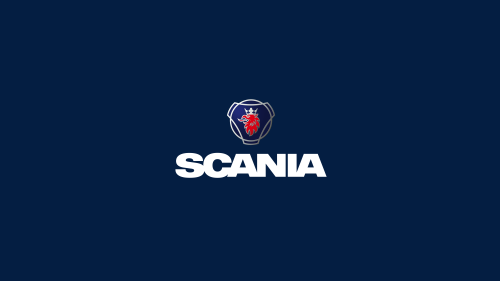Film
Video is an increasingly important means of communication, and is a possibility for Scania to communicate our message in a highly desirable form of content.
The principles for applying the brand assets on film and motion outline the do's and dont’s when producing film. The aim is to harmonise the representation of the Scania brand across all content and channels.
Storytelling in film
Scania's core values include putting the customer first and respect for the individual. To reflect this, video content should, when relevant, include a customer's perspective, and the main messages of the video should be communicated both visually and audially.
- A video’s narrative arc should be expressed through three main channels: on-screen narrative text, interviews, and voice-over audio.
- Videos should, when appropriate, be people-driven and include one or more interview subjects.
- On-screen text, also known as supers, can be used to provide the main narrative arc of a story or supplement interviewees’ comments when needed.
- On-screen text should be short and easily read over a background that complements and does not distract from the message.
Rationale for decisions:
- Producing videos according to this style maximises viewability and allows for videos to more effectively be used across platforms and channels.
- Focusing on customers and people reflects Scania's core values and makes the film more relevant and interesting for the viewer.
- The use of on-screen text and subtitles allows for viewers to fully understand and appreciate what is being communicated, even when the sound is turned off.
Logotypes in film
Animated end logo
To ensure a strong unified global visual identity all films produced by and for Scania must end with a Scania logotype. The logotype is designed to harmonise with our sound logotype, but stand just as well on its own.
If you wish to add additional messages or other information such as an URL, do so on a separate frame before the end logo.
Still end logo
As an alternative to the animated end logo, a still end logo may be used. This may be useful for shorter clips for social media.
To apply the still endlogo:
- Use the specific artwork available.
- Choose between the image or white background.
- Add a 1.5 second fade-in effect. Do not add additional effects to the endlogo.
- Fade out to black or leave the endlogo as the final frame.
If you wish to add additional messages or other information such as an URL, do so on a separate frame before the endlogo.
Backgrounds
The primary version of the animated logotype is designed for a blue background, but it's also available on black, white and transparent backgrounds. Please note that only these versions are allowed. The logotypes may not be altered and no other motion may be added to the Scania logotype.
Blue background
Our default logotype version and strongest brand carrier.
Black background
A secondary version that may be used if black suits better with the footage.
White background
A secondary version that may be used if a lighter version suits the footage better.
Transparent background
May only be used on calm footage and must never cover any main object, such as a truck.
Formats
The motion logotype is available in different formats to cater for different needs. The standard format for film is 16:9, but it's also available in 9:16, 4:5 and 1:1 for different social media platforms.
Opening sequence
Depending on which type of film you are producing, a logotype can also be added in the opening sequence. Another option to show who the sender is even if the viewer does not watch to the end, is to show a product with a clearly visible logotype or to display Scania in introtext.
If using a logotype at the beginning of the film, always use the vertical lock-up logotype. The size of the logotype is set to 50% of the width of the screen and the artwork is vertically and horizontally centered. For standard widescreen formats (16:9) use the endlogotype artworks.
For opening sequences, there are two ways to apply the Scania logotype:
- Fade-in: The logotype fades in on top of a coloured background. The fade in time should be set to 0.5 seconds.
- Still: The logotype simply appears as part of the intro of the film, on top of a coloured background.
If you want to add text, please follow the instructions in the typography section.
Don'ts
Typography in film
To harmonise the use of typography in film, let the following principles guide your work:
- Always use a font from the Scania Sans typeface family and apply the typographic settings that are outlined in the chapter on Typography.
- While Scania in general always align text to the left, in film an exception is made. For key messages or added information such as a URL, always center text both horizontally and vertically. For names and titles text is left aligned, preferably in the lower left corner.
- Links/CTA are always displayed on a separate frame before the end logo.
- As a rule, always use white text when possible. Subtle shadowing can be applied to text when the film is very bright to ensure high readability.
- Be mindful of the duration and length of the message, so that there is enough time to read the text. For longer text, consider dividing it into several screens to make it more digestible. Additionally, it's important to be cautious when using text on top of footage to ensure that the text is legible.
- Use any of the motion treatments Simplified, Default or Expressive, as described on the Motion page.
- For the use of other graphic elements in film, please also refer to the separate Infographics and Pictograms sections.
Short copy
For main messages and short copy (max 3 rows), use Scania Sans Headline Bold (or Regular). Leading: 95%.
Long copy
For longer copy or more subtle text (e.g. editorial text) use Scania Sans Regular (or Bold). Leading: 125%.
Names and titles
Names and titles are set in Scania Sans Bold and Regular respectively. Text is left-aligned and preferably placed in bottom left corner. Leading: 125%.
Subtitles
Use Scania Sans for subtitles. If needed you may add a subtle shadow or semitransparent grey to the textbox.
CTA
Call To Action (CTA) messages and links are always displayed on a separate frame before the Scania end logo. The text is preferably set in Scania Sans and centered vertically and horizontally.
Read more about typographic settings: Typography
View guidelines for motion treatment of text and graphics: Motion
Voice, music and sound
The sounds added to a film affects the experience of the Scania brand. Therefore, when recording a voice over, selecting music or adding sound effects to your film, always be mindful of Scania’s sound identity and tone of voice.
Scania's sonic concept Advancing with presence and sonic principles Precision, Presence and Drive is the basis of our sound identity and guide sonic decision making and production. Read more and download several useful sonic assets on the Sound page.
Imagery
Scania’s brand imagery should always be grounded in reality: our own, and that of our customers. Neither images nor films should look fake or overly retouched. We use natural light with depth of field, showing real people in real situations. This way Scania is always present and shows that we understand our customers and every bit of their business.
Illustrations
Through a clear and consistent illustration style we can unify the visual expression of our illustrations at Scania.
The monochrome use of colour and a simplified clean illustration style result in a professional stylistically pure expression.
If you must use colours to highlight details or parts of your illustration always use any of Scania’s brand colours, primarily the primary and supporting colours.
Combining product and environment illustrations can be a powerful tool to support communication. Good examples include using illustrations to outline features of transport systems and logistic flows, to present product and service features and to clarify size and scale relationships.
Additional information
Privacy laws and authorisation
- According to applicable laws on privacy, all persons appearing in a film must sign a written release permitting storing, processing and publication of the film. A film including a person, who has not given a written consent, must not be used.
- Suppliers (e.g. photographers and agencies) must sign a release authorising free use of their photos for commercial purposes in the whole Scania organisation.
- Make sure you have the right permits for shooting on the site.
Templates for agreements for people/models are available via the communication support site on Reflex or by contacting Scania Image Desk.
Equipment and quality
- Always shoot in at least full HD i.e. 1080p (progressive).
- Preferably shoot in PAL 25 fps or 50 fps if possible. Varied framing makes it easier to do good editing.
- Make sure to take some establishing shots, but don’t forget the details.
- Use a tripod or other equipment fors tabilisation. Make sure to use windshield on all microphones when filming outdoors.
- When shooting aerial footage, for example with a remote controlled drone or from a helicopter, make sure all permits are in order.
- Always use as low compression rate as possible when delivering the material.
- Always use professionals for more advanced productions, consider hiring a production agency.
- Always ensure that you own the world wide usage rights to any material that you share.
Video standards
In order to maximise the use and value of our video assets, the following video standards have been set to ensure a consistent, predictable and high-quality video experience.
- Videos embedded into ComOn are hosted on YouTube
- Videos embedded into ComOn are subtitled in all relevant languages
- All subtitles on videos embedded into ComOn are softcoded
- Softcoded subtitles may be in .srt (UTF-8) or .vtt format
Rationale for decision:
- Video assets shared between YouTube and ComOn maximise opportunities for video engagement and provide cross-platform tracking.
- Subtitles are used to ensure our visitors can engage with our content in their preferred language(s).
- Soft-coded subtitles are used to enable future editing of information and to minimise file storage requirements.
- SRT file formats are easy to work with, while .vtt file formats support advanced features like positional information.
Tools
External communication material and productions for a larger audience should only be produced by the central communcations functions and not by individual employees.
For internal films of a more basic character there are several tools available. Please note that if you use AI to create or modify a film, it needs to be clearly marked. Read more in the guidelines for Artificial intelligence.
Some tools are available via Microsoft 365, e.g. PowerPoint and the video editing tool Clipchamp. Please note that all guidelines for use of the Scania graphic identity always apply, e.g. use of logotype, fonts, colours and imagery. For presentations and films created in PowerPoint, always use the Scania template including the correct logotype, fonts and colours. Click below to download a brand kit (with logotypes, colours, fonts etc.) for use in Clipchamp.

